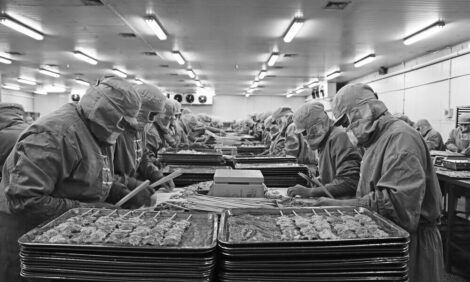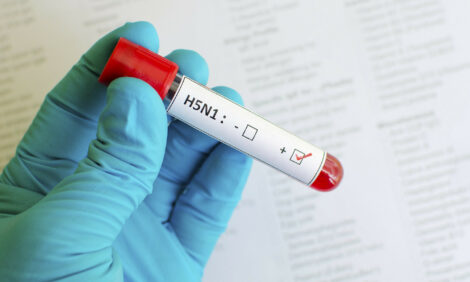



Biosecurity Guidelines Help Protect Viet Nam's Poultry Supply Chain
VIET NAM - Biosecurity guidelines developed by various agriculture organisations in Viet Nam have helped smaller hatcheries and parent flock farms to improve animal health and protect the poultry supply chain.With rapid economic growth and expanding urban populations in Viet Nam, demand for food has been increasing at a fast pace in recent years.
Poultry is an important source of animal protein in the country. According to 2014 figures from the Hanoi Trade Department, approximately 4,650,000 kg of poultry meat is consumed monthly in Viet Nam’s capital Hanoi.
Many individual households manage their own small and medium-sized parent flock farms or hatcheries to support this vast urban demand and gain extra income.
In order to support these small and medium-sized poultry farmers, FAO Viet Nam' s Emergency Centre for Transboundary Animal Diseases (ECTAD) and the Department of Livestock Production (DLP) of the Ministry of Agriculture and Rural development (MARD) developed basic biosecurity standards for small and medium-scale parent flock farms and hatcheries.
The initial assessment phase and pilot project was funded by the United States Agency of International Development (USAID). By implementing simple measures at twelve pilot farms in the Quang Tri and Can Tho provinces, farmers experienced a significant change in their businesses and working environments while protecting their flocks against diseases including avian influenza.
FAO is now working with the World Poultry Foundation to build on lessons learned and reach a larger number of farmers across Viet Nam with the aim of finding a sustainable solution for hatchery improvement nationally.
Promoting a healthier environment for both poultry and farmers
FAO's poultry value chain assessment programme showed that small or medium-scale poultry parent flock farms and hatcheries in Viet Nam are lacking guidance and know-how on implementing and managing clean and safe farm operations.
Poor biosecurity conditions contribute not only to low quality products, but also to the spread of pathogens, environmental pollution, and health threats for workers.
In fact, poor biosecurity in poultry farms has been recognized as one of the factors that contributed to the emergence and spread of H5N1 avian influenza since 2003, threatening food safety along poultry value chains in Viet Nam.
While larger farms in Viet Nam were provided with Viet GAHP (Vietnamese Good Animal Husbandry Practices) biosecurity guidelines by MARD, these guidelines are not suitable for small and medium-scale poultry breeder farms and hatcheries.
Introducing simple, practical, and feasible biosecurity measures for safer and cleaner hatcheries
As part of the pilot project, 15 simple biosecurity measures were implemented in 12 duck farms and hatcheries in the Quang Tri and Can Tho Provinces.
These measures included introducing new feeders and low-cost nests, separating flocks from the farmer's living area, implementing improved hygiene practices such as egg fumigation, and applying more effective management methods.
Just three months later, farmers witnessed significant changes in their lives. Egg productivity rates and quality increased. Mr Son, who participated in the project, noted that after implementing the new biosecurity measures, he was able to increase hatching of his 850 laying ducks to result in 2245 extra ducklings that hatched over two and a half months and generated 530 US$ of extra income.
Furthermore, general flock health was improved with fewer cases of diarrhea and lower culling rates of laying duck. Farmers also noted more pleasant working conditions with cleaner and better-smelling farms.
During the three-month implementation of the project, hatchery owners gained between US$271 and US$ 4 327 in additional income from increased hatchability rates. The increased survival rates during the duckling’s first week of life also improved the hatchery’s reputation among buyers and thus increased business.
All of these changes resulted in reduced working hours and a better quality of life for local farmers.
Training is fundamental to establishing good biosecurity at the beginning of the poultry value chain
Based on the successful result of the pilot project, the “Guidelines on biosecurity minimum measures for small and medium scale hatcheries” and the “Guidelines on biosecurity minimum measures for small and medium-scale poultry breeder farms” were both officially issued by MARD.
Establishing good biosecurity practices at the beginning of the poultry value chain has made a difference in twelve pilot farms in Viet Nam. FAO and its partners are aware that training is central to ensuring continued success.
Training and advocacy films will be used to raise awareness and inform more farmers about simple farm management practices that can improve their livelihoods by increasing productivity, decreasing disease and improving food safety. Additionally, FAO, in collaboration with the World Poultry Foundation, has developed a training manual which will be rolled out to a broader group of small hatchery owners across Viet Nam.








